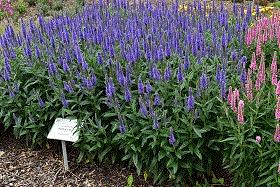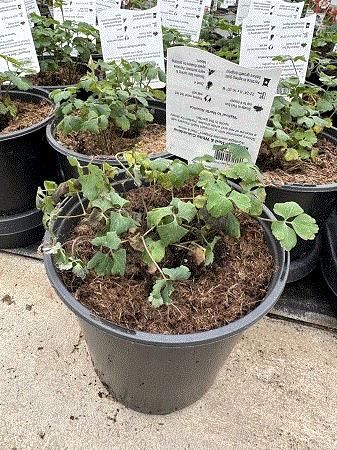What’s Happening Here?
For the first challenge of the year, I wanted to show a timely issue and discuss how it can be prevented. Before I get ahead of myself, take a look at this aquilegia:
In case you’re having difficulty seeing what I’m intending you to see, look at the container in the foreground, particularly the plant on the left side of the pot. I’m hoping you can see this plant appears slightly wilted. If you can’t quite see it, trust me that one of the two plants in this pot is wilted.
I’m guessing many of you already know a few factors that cause plants to wilt, but which one is it? With that, the time has come for me to ask, “What’s happening here?”
Stay tuned—I’ll reveal the answer and discuss it further at the end of the newsletter.
CSUs Top-Performing Perennials of 2024
Colorado State University recently announced the best of the best from their perennial trials. These selections have not only received the highest plant ratings (>4 out of 5), they also had near 100% survival rates over the last three years (two winters and three summers).
Delphinium Delgenius Chantay (Pacific Plug & Liner)
A staple in an English-style garden, delphiniums can be quite a showstopper for their impressive flowering stems. And
Delgenius Chantay doesn’t disappoint! This robust, mid to late spring flowering perennial has flower power. Each plant produced several rich, robust lavender-dusty antique pink spikes with clean white centers. The plants sport deep green, dissect foliage for most of the season, leading to a second flush of flowering in early to mid-fall. Staking or providing support for the heavy flowering spikes is recommended! Hardy to Zone 3.
Perovskia Jelena (Dümmen Orange)
Do you want a sturdy Russian sage for the garden? Then you should consider
Jelena. This selection has the typical lavender blue flowers, prolifically flowering from early summer and into the fall. This is a great landscape plant that's a good candidate for a lower water input garden! In the CSU Gardens, it reached a very uniform ~36- to 48-in. tall with no lodging! (If grown drier, one could expect it to be closer to ~18 to 24 in.) It's a pollinator magnet with beautiful gray-green dissect foliage. Hardy to Zone 4.
Rudbeckia Goldblitz (PanAmerican Seed)
If you’re wanting an alternative to Goldsturm, give
Goldblitz a try! This seed-grown rudbeckia can be a first-year flowering plant with a slightly shorter production time and slightly earlier flowering—a real benefit in retail garden centers. In CSU's trials, it was an earlier flowering rudbeckia with very uniform and consistent performance over the three-year period. The 24- to 30-in. plants with golden ray florets and a rich deep brown cone showed great vigor with dark green foliage all the way to the end of the season. Another great plant for pollinators in the landscape. Hardy to Zone 3.

A Couple More Top Performers
Sedum Conga Line (Terra Nova Nurseries)
You'll want to invite this one to your dance party!
Conga Line has beautiful deep green foliage that gradually matures into a deep purple green later in the summer. By mid-summer, the red-purple-colored flower bud clusters develop, ultimately opening into eye-catching peachy-cream dallops of color on top of upright branches. Even in CSU's trials with more consistent irrigation, the stems were strong and upright. Like most of their sedum faves, this one is also a waterwise plant, handling lower water inputs and is agreat pollinator plant to boot! Oh, and it handles the cold—hardy from Zones 4 to 9!
Veronica Skyward Blue and Skyward Pink (Darwin Perennials)
|

Skyward Blue
|

Skyward Pink
|
Aptly named with dozens of spires of rich violet-blue and vibrant pink pointing to the stars. Both
Skyward Blue and
Skyward Pink are well matched in this series. Copious amounts of spikes begin in late spring, shooting off like early fireworks in the gardens and with intermittent shows all the way into fall with simple deadheading. The dark green, lush foliage is more resistant to powdery mildew than Moody Blues. Either of these speedwells would be a great addition to the perennial border. Hardy to Zone 4.
These perennials and CSU's top performers mentioned above are all great plants to consider growing and offering to your customers. Unfortunately, I didn’t have space in this week’s newsletter to feature all of CSUs Top Performers for 2024. (Yes, there are more.) I wouldn’t want to omit and deprive you of the other selections, so here they are:
Even though I couldn't feature them here by no way does it imply the plants in the above listing are honorable mentions. On the contrary—they were definitely top performers in CSU's trials.

The Benchmark Advantage
Have you ever wondered how your business compares to your peers? The Perennial Plant Association (PPA) is holding a special webinar on this very topic next week. Grab your lunch and join the PPA virtually next week as a group of presenters share how they use benchmarking at their operations
When: Tuesday, February 4, 2025
Time: 12:00-1:30 p.m. Eastern/11:00-12:30 Central
Location: From the comfort of your office, home or wherever you choose (Virtual on Zoom)
Presenters:
-
Loma Vista Nursery—Ottawa, Kansas
-
Pleasant Run Nursery—Allentown, New Jersey
-
Plantworks Nursery—Rougemount, North Carolina
The presenters will share how they use benchmarking in their operations, what metrics they use, share their backgrounds and processes, and take questions from you. The cost is $15 for members/$30 for non-members and group pricing is also available. Visit
The Benchmark Advantage for more info.
The Answer is ...

I shared this image at the top of the newsletter and asked if you knew what was causing one of the two plants in the container to appear wilted. Is the cause of the wilt as obvious as you think? Let’s find out ...
As you can likely see, this is a recently planted crop of aquilegia with two plugs transplanted into every container. Unfortunately, this image only shows a small portion of the crop, however, I can tell you that other containers also contained one or more plants that appeared wilted.
There are several reasons why plants wilt. Some of the most common ones are: moisture (drought), root rot, bacterial wilt, borers, high salts (EC) and freeze injury. Many of these options would most likely affect both of the plants rather than just one of them. Having said that, which one of these options could cause one plant to show symptoms and not the other?
If your answer is moisture (drought), you’re correct. If that’s the case, do you know why only one of the plants in the container is showing symptoms? Let’s take a closer look:
Compared to the growing mix in the container, the moisture of the original plug is extremely dry, resulting in the development of drought symptoms. In this case, some dry plugs were planted and they continue to dry down over time even though the crop was watered after planting.

Why This Occurs and How to Prevent It
The most likely explanation for the dry plugs in this week’s challenge is some of the plugs were dry at the time they were planted. Unless the trays were properly hydrated prior to planting, it’s not uncommon for liner trays to be dry before they're transplanted or for them to have variable moisture levels from cell to cell.
Many growers assume watering the containers after planting will sufficiently wet the plugs. Unfortunately, that's not the case. The smaller particle sizes of the growing mix of the plugs and the larger-sized particle sizes in the final containers don't easily allow water to move into the original plug. As a result, dry liners and plugs will remain dry and will continue to dry further unless an incredibly large amount of irrigation is applied after planting. Even a ridiculous amount of water may still not be enough.
The best option is to thoroughly water plugs and liners before planting. Research has shown how properly moistened liners establish quicker than dry ones. The moisture level of the plug has more influence on plant establishment than the initial moisture level of the growing mix they're planted into.
-
Dry plugs into dry soil results in poorer establishment
-
Dry plugs into moist soil results in poor establishment
-
Moist plugs into dry soil results in moderate establishment
-
Moist plugs into moist soils results in the best rooting and establishment
The bottom line is the moisture level of plugs and liners is more important than the moisture level of the containers they're planted into. I find this is true for all types of plugs: loose fill, stabilized substrates, Elleplugs and Growcoons.
To ensure the quickest and best initial rooting and establishment, consider watering ALL plugs and liners BEFORE they're planted into the final containers. Since there's often moisture variability from cell to cell be sure to water them thoroughly. Some growers will water them with a wetting agent to help the liners hold moisture during their transition.




My email is paul@opelgrowers.com if you have any comments, article suggestions or if you'd just like to say hello.
Best regards,

Paul Pilon
Editor-at-Large—Perennial Pulse
Director of Growing—Opel Growers
This email was received by you and 34,356 other fine subscribers!
If you're interested in advertising in Perennial Pulse, contact Kim Brown ASAP and she'll hook you up.